
Photo: Disney
ROBIN HOOD
Welcome to Revisiting Disney! Today, we’re looking at that movie which brought a legend to life for a whole generation in a new way, Robin Hood! Like always, I have labeled each category so if you want to skip to the parts that interest you most, feel free. And, of course, if you have any thoughts, burning or otherwise, please share in the comments!

BACKGROUND OF ROBIN HOOD
Robin Hood was released in the US in 1973, with an LA release on December 21st and a New York City release on November 8th. Originally, the film looked very different.
The initial plan, years earlier, had been to have the story based on the fable of Reynard the Fox, but Walt had been concerned over adapting the story. To address those concerns, Ken Anderson began borrowing from the Robin Hood legends. Over time, the Robin Hood aspect overtook the Reynard aspect. Some things, however, remained, such as the fox and the wolf as opposing forces (Robin and the Sheriff).
The story was also, according to the Internet Movie Database, at one point supposed to be set in the Old West. Several of the voice actors, Pat Buttram, Andy Devine, George Lindsey, and Ken Curtis, were known for their work in westerns, and it has been said that the originally western setting is the reason for their casting.
Robin Hood was the first Disney animated film to have an entirely animal cast, which is fun, particularly because the animals behave like humans. Like with The Aristocats, animation historian Bob Thomas is less than complimentary but doesn’t seem to regard Robin Hood as a total failure. Historian, Christopher Finch mentioned that part of the reason the Robin Hood was the next Disney film was because the Studio was looking to adapt another “classic,” and Robin Hood, being a popular classic story, was suggested (Finch 1975:127).

The Robin Hood legend has been around for ages, and there are many reiterations of the story. Personally, it’s one of my favorite things, and though I don’t have as much Robin Hood related books and films as King Arthur related books and films, it’s still a respectable pile. Plus, a lot of things are similar to the Robin Hood legend (so they could, theoretically, count). For me, this is a special film, so please indulge me in a stroll down memory lane?
I remember being really excited to receive the VHS tape for my birthday when I was a youngling. I also have memories of my mom helping me make a costume (i.e. I helped my mom make me a costume by providing artistic input and saying thank you) and dressing up as Maid Marian (with my baby sister playing the part of Lady Cluck). I had the fox ears, protective ear hat, everything. We took imagination seriously at my house growing up (often using props).
I was really excited by my fabulous costume though I also remember not wanting to leave the house (because I was shy when playing dress-up). I also went as Maid Marian for Halloween one year in Elementary School, although I went as the human version that time.
Growing up in the forest, I never played Robin Hood, but I played at being Robin Hood’s daughter all the time (she did all the same things, but was a girl with a whole slew of Uncles living in Sherwood Forest, sometimes pardoned, sometimes not). I’m telling you all this because, for me, this is one nostalgic Disney movie that had a deep impact on my childhood. I have tried to look at it as objectively as possible, but there was more of a bias going into this one than for the others thus far.
MUSIC
The opening number was, as a kid, one of the best opening numbers in a Disney movie ever. It showed me the characters, set up the conflict, was a catchy tune, and I knew how to whistle it. Part of this number was later adapted and sped up to become “The Hamster Song,” which you may recall. It’s the kind of number that gets stuck in your head with frightening ease.
This week, as I was researching, I learned that there is an official name to this number. It’s called, “Whistle-Stop,” which is a very clever title, if you think about it, and it proves that you learn something new every day! As an adult, I still love this number.
Three songs, “Oo-de-lally,” “Not In Nottingham,” and “Whistle-Stop” were written and performed by country singer Roger Miller (who played Alan A’Dale and acted as our narrator). “Love,” the romantic ballad, was sung by Nancy Adams and written by Floyd Huddleston and George Bruns (who also wrote the music). The final number, “The Phony King of England,” was written by Johnny Mercer (and sung by Phil Harris).
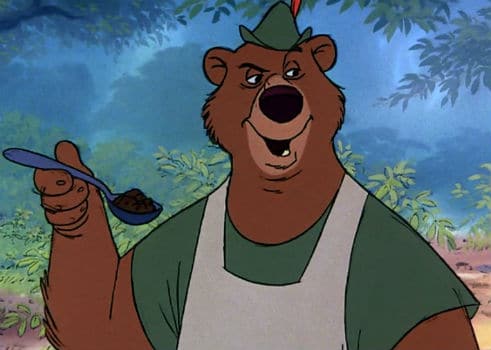
“Not in Nottingham” would be adapted by “Mumford and Sons” later on, and although “The Phone King of England” and “Whistle-Stop” are my two favorite numbers, all of the songs are ones that you can sing along with and enjoy. In 1974, the song “Love” was nominated for an Oscar in the category Best Music, Original Song.
As will all scores composed for Disney by George Bruns, the background music weaves bits of the songs into the film, tying the whole musical experience together in a more cohesive manner. In addition to that, the score does a wonderful job of influencing the viewer’s emotions with the changing tempos and rising pace, but it does it in a very subtle way.
The score and the animation go together beautifully; the score complements the animation without drawing too much attention to the music. Again, it’s subtle, and I like that. The film’s music was nominated for a Grammy in 1975.
ANIMATION
We have, again, several familiar faces in the making of this film. Larry Clemmons wrote the story, basing it on characters and concepts by Ken Anderson. The directing animators were again Milt Kahl, Ollie Johnston, Frank Thomas, and John Lounsbery while Thomas and Anderson worked on story sequences as well.
When looking at character animation, Eric Larson is again listed, but this time, Don Bluth is listed as well. Although not his first film with Disney, it was the first time he was important enough to the process to be listed. We’ll come back to him later. Wolfgang Reitherman was, again, the director and producer.
RELATED: Revisiting Disney: The Sword in the Stone
In Revisiting Disney: The Sword in the Stone, I talked a bit about Wolfgang Reitherman, and just wanted to add something to that. Reitherman loved to reuse bits of animation in films he directed, and Robin Hood is no exception. The dancing during the “Phony King of England” is from Snow White, The Aristocats and The Jungle Book, all calling back to previous films. He found it fun, according to interviews and DVD extras, to add those Easter Eggs for Disney fans.
In this film, much like in The Aristocats, the animation of each character is highly influenced by the actor who voiced him or her. Christopher Finch cites Prince John as an example of this; he has many shades of his voice actor, Peter Ustinov, in his mannerisms and appearance.
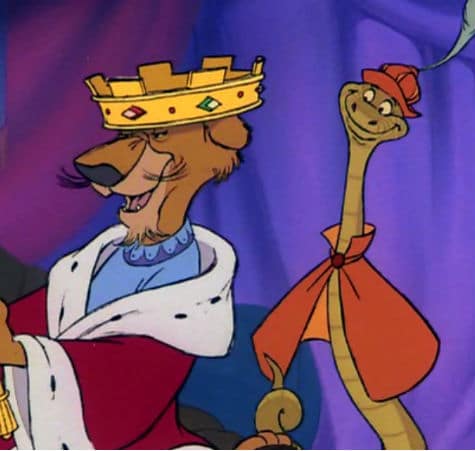
Finch says that the animators, particularly Ollie Johnston (who did the initial work on Prince John), were “very much guided by Ustinov’s interpretation of the character,” though Finch also makes a point of mentioning that many animators worked on the animation of Prince John (Finch 1975: 128).
The backgrounds are also a lot of fun, because they are very detailed with some things, while not with others. It’s like the artists know what your eye will be drawn too, and add more detail to that. Usually, it’s the big set pieces, like the trees or buildings, that are more detailed, and maybe the flowers that are closer to the audience are more abstract.
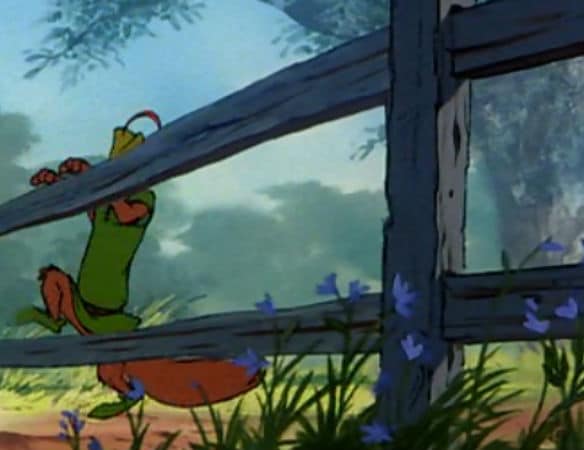
This photo kind of shows what I mean. Your eye is drawn to the fence, the trees (both show and not), and Robin himself, and the flowers are less important, but still part of the shot. I may be analyzing this too much, but that’s kind of how the style seems to me; the backgrounds are beautiful and have just the right amount of detail in the right places while knowing where too much detail will be overwhelming. The colors are great and contrast the characters well. It’s lovely.
THE PLOT
After a wonderfully upbeat musical number introducing the voice actors and animation crew, Allan A’ Dale, our narrator introduces himself and starts the story. He opens the story with Robin Hood and Little John, just hanging out in the Forest when the Sheriff of Nottingham and his men finds them. Despite the fact that the Sheriff and his posse (as the song says) are shooting at them, Robin and Little John manage to swing into a tree and escape.
Robin Hood and Little John are a wonderful duo with Robin being more inclined to engage in risky behavior and Little John being more prone to being cautious. Working together, I imagine they keep each other out of a lot of danger; Robin plans things and Little John weighs the risks and runs all the backup plans. The two are chatting and hear a caravan approaching, and begin to make their plans to relieve the wealthy persons from some of their money.
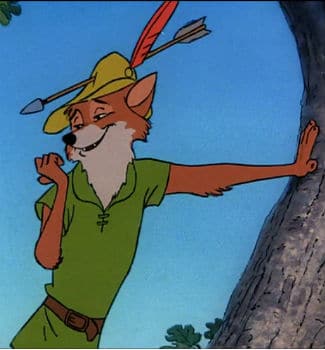
It turns out that the caravan is escorting Prince John to Nottingham, carrying a large portion of the taxes he has just collected, and traveling with his adviser, Sir Hiss. Despite the advice of Sir Hiss, Prince John is convinced that there are no female bandits, so, when Robin Hood and Little John proceed to rob the Prince blind while disguised as female fortune tellers, he is quite bashful and angry to be proven wrong.
In Nottingham, we met the Sheriff of Nottingham and see first-hand the effects of over-taxation on the town, both through the scenery and the in-town scenes. Friar Tuck delivers a bag of money (for food) to Otto, the injured blacksmith, the Sheriff finds and takes that money, and poor Skippy the Rabbit loses his birthday gift (he’s turning seven and he got a farthing).
Luckily, Robin Hood arrives in disguise to hand out money and gives Skippy a bow, arrow, and his own hat. It’s been Skippy’s best birthday ever. Unfortunately for Skippy, he shoots his new arrow into the palace yard. However, because of his mistake, Skippy and his friends (and sisters) meet Maid Marian and Lady Cluck, where we learn that Maid Marian and Robin Hood had been sweethearts before Maid Marian went to London.
Since kids tend to ask noisy questions, Skippy and his siblings proceed to do just that, asking Maid Marian about her relationship with Robin Hood, but since the audience was wondering anyway, they’re forgiven. Deciding that Marian and Lady Cluck are alright, Skippy pretends to be Robin, on a mission to rescue Maid Marian from evil Prince John (played by Lady Cluck). It’s a really hilarious sequence (though as a kid I remember being super concerned that Lady Cluck was going to be caught and arrested for being disrespectful of her monarch).
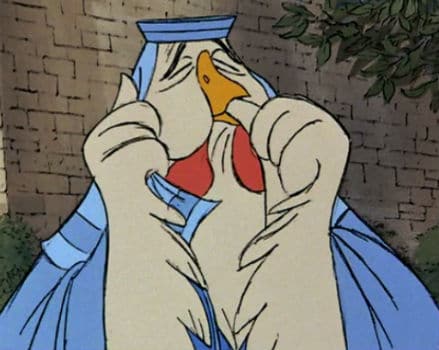
Now that we’ve set up the romance, Marian, who in this story is the niece of King Richard and Prince John, reminisces to Lady Cluck that she’s still in love with Robin Hood, but is worried he’s forgotten her.
Of course, the next scene is Robin Hood and Little John at camp, discussing the Robin Hood/Maid Marian situation. He’s still in love with her, but he’s an outlaw, so he doesn’t think he can provide her with the type of life she deserves, and he doesn’t know if she remembers him.
Little John is one of the best sidekicks ever, and this scene proves it. He both affirms his friend and reminds him that yes; he is kind of a big deal, but he also provides comic relief when Robin needs it. When Robin asks what he could offer Marian, Little John’s response is to tell him that he can’t cook, so that’s out. They just have some wonderful interactions.
Friar Tuck shows up and tells them that Prince John is having an archery tournament the next day, with Maid Marian giving a kiss to the winner. It’s obviously a trap, but Robin Hood is determined to attend and win, so he and Little John develop a scheme to sneak in, in disguise.
The scheme almost works, but because he is known far and wide for his skills at archery, by winning Robin gives himself away, is caught and sentenced to be executed. Maid Marian pleads for his life, to no avail, so Little John steps in and convinces Prince John (with a knife to his back) to let Robin go.

A fight breaks out, which is, of course, the time Robin chooses to propose (she says yes). After the fight and the romantic ballad, it seems like the entire town ends up at Robin and Little John’s hideout. Here, the hilarious song, “The Phony King of England,” is performed.
When the Sheriff and Hiss make the poor choice of singing said song where Prince John can hear it, the understandably annoyed Prince raises taxes again, arresting everyone who cannot pay. Soon, the entire town is in prison for being unable to pay. Overkill, much? As a kid, I was curious how someone could pay off debt if they were unable to work, and this led to another fun discussion with my parents. Seriously, I thought it was a fun discussion.
Friar Tuck, after the Sheriff takes all the money from the poor box at the church for tax purposes, loses his temper. In the resulting fight with the Sheriff, he was winning until one of the Sheriff’s men flips the hood of his habit over his face, giving the Sheriff the upper hand.
In a final attempt to capture the elusive Robin Hood, Prince John decides to hang Friar Tuck, prompting Robin Hood and Little John to stage an elaborate jailbreak. This frees not just the Friar, but the entire town and all the gold in the royal treasury. The rescue goes according to plan until Hiss wakes up and sees Robin, sounding the alert.
When one of the children somehow gets left behind, Robin Hood sacrifices his chance to escape to save her. What follows is one of the most exciting climaxes to a Disney film ever; Robin Hood fights his way out of the palace that is crawling with soldiers and guards only to be met by the Sheriff. The two of them fight and in the process, the palace catches on fire.
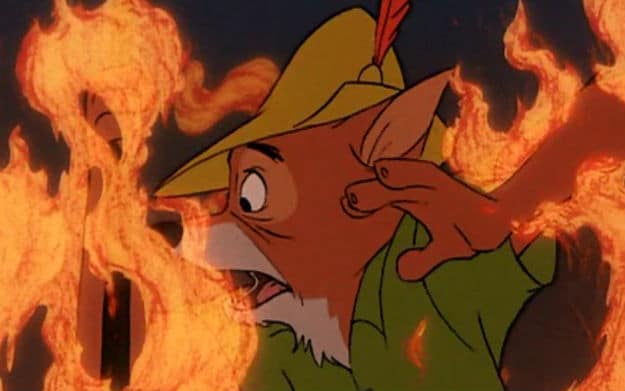
Robin escapes to the roof and has to dive into the moat. Prince John orders his archers to kill Robin, so they fire into the moat. When Robin’s hat surfaces with an arrow in it, they assume he’s dead. He’s not, because it’s a movie for kids and it’s his movie, and he surfaces near Little John and Skippy.
Out of reach of the arrows, they call out to Prince John that he has failed in his scheme to kill Robin Hood, suffered a massive jailbreak and lost all his gold. Hiss chastises John for his bad trap that resulted in the burning of the Queen Mother’s castle, and the Prince proceeds to chase Hiss around the castle with a stick, sucking on his thumb the whole time.
We cut back to Allan A’Dale, who tells us that, luckily, King Richard returned soon, and “straightened everything out.” We see Prince John, the Sheriff, and Sir Hiss working at a rock quarry while wearing prison garb. At the same time, we hear church bells, and realize that someone is getting married.
It turns out to be Robin Hood and Maid Marian, with King Richard in attendance. He makes a joke about having an outlaw for an in-law, and Skippy goes along with Robin, Marian, and Little John to help keep an eye on things. We get one more look at the prisoners and the now happy citizens of Nottingham before the carriage pulls away. The music starts to play and, we assume, everyone lives happily ever after.
SOURCE MATERIAL
The legend of Robin Hood has been told and retold almost as many times as the Legend of King Arthur, and because many countries have their own variation on the legend (Zorro counts here), he might just be slightly more popular. Even if you just look at the Robin Hood legend based in England, you have a large body of work to work off.
Stories based on Maid Marian’s life? We have that. Historically based revising of the story? Retellings with a modern twist? We have those. Stories where Robin Hood plays a short but critical role? Ivanhoe. Books have been written focusing on the romantic angle, the political angle, the historical angle, and the relationship between Robin and the Sheriff. There have been stories with Robin as a woman (her prince is trapped, usually), and stories with a modern twist.
In addition to the book versions, there are also the film versions. The earliest Robin Hood film that I could find is from 1922 and stars Douglas Fairbanks as Robin Hood though the 1938 version with Errol Flynn might be better known. Like with the books, there are modern retellings (Hood looks very intriguing), new viewpoints, striving for more historical context, and a film with the characters portrayed as older.
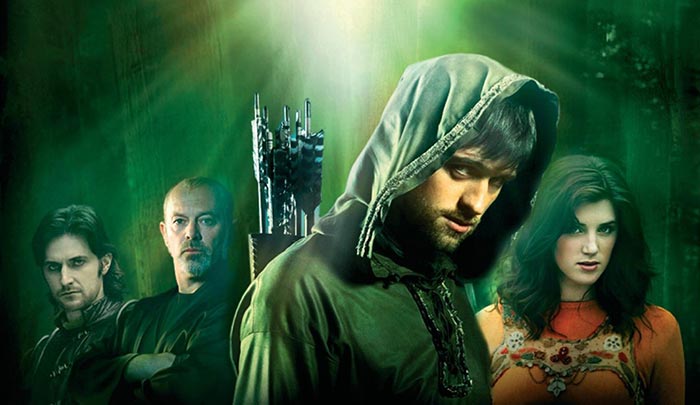
Photo: BBC Worldwide
There have been several shows with Robin Hood as the main focus. Three come to mind first, a miniseries in the 1970’s and two other shows that aired in the UK. “Robin of Sherwood” ran from from 1984 to 1986, and the new “Robin Hood” ran on BBC from 2006 to 2009. I haven’t seen the 80’s series, but the new one is quite fun (although there were some questionable choices. End of Season Two, why?!). It’s still worth the watch if you need another show to watch on Netflix.
Mel Brooks has done a parody of the Robin Hood films (Robin Hood: Men in Tights), and there was a TV movie about Robin Hood’s daughter (starring Keira Knightly). Robin Hood also appears in Once Upon a Time on ABC and in the miniseries Ivanhoe, and was in an episode of the animated series The Pink Panther, among other things. Finally, in 2017, Robin Hood: Origins is set for release, another twist on the legend we all know and love.
RELATED: Classic Romantic Moment: Robin Hood and Maid Marian
Not only has the legend been rewritten and retold many times, but there are the legends themselves. Legends, songs and poems have been passed down for centuries, and although some details differ, they all have some basic things in common.
In all of them, Robin Hood has to go live in Sherwood Forest to protest injustice against the common man. He robs from the rich for the poor, and he hunts the king’s deer to feed the starving as well. He loves the beautiful Maid Marian, who loves him as well (and they are almost always very adorable), and has a band of Merry Men that assist him in his endeavors. In the end, he is always pardoned by the King, usually King Richard.
Other things are less stable. Sometimes, Henry is the King, other times, John is acting King and Henry has died. Occasionally, Robin Hood dies of old age in the end. In some stories, Marian goes with him to the forest, and in others, she waits for him to be pardoned.
Usually, Robin Hood is a nobleman before going into hiding, but that’s not always the case. Sometimes, Robin Hood accidentally breaks the law and that’s what sends him into exile, sometimes he runs to make a statement, and sometimes he is careless and has to flee to the forest.
Basically, it’s a very rich legend ripe with possibility, begging to be written and adapted for a new audience. As long as the main part of the story remains, robbing the rich to feed the poor and helping the helpless, the spirit of the original legend lives on.
The 1970’s
I know I promised to talk about Watergate this week, but looking at my notes again, I realized that when Robin Hood was released, Watergate was still happening, so I’m going to put that off for one more week. We will get to it, I promise!
At the risk of saying exactly what I said last week, however, the social and political issues of the 1960’s persisted into the 70’s. Groups that were marginalized were still struggling for equality, and the anti-war movement began to surge. And again, there was a counter-movement, aimed at returning things to the way they were in the 1950’s, both the conservative political atmosphere and the roles of men and women.
The 70’s were the decade of Olivia Newton-John, bellbottoms, and Happy Days, but they were also the decade of Watergate, an increased battle for equality among the citizens of the US, and continuing conflicts abroad.
Like The Aristocats, Robin Hood fits the decade beautifully. It’s really a quite hilarious film and with the catchy music, it distracts from the serious current issues and makes the audience laugh at the same time. I think one of the morals, doing the right things isn’t always easy, could be applied to the struggles faced in the 1970’s. Standing up for what’s right can be hard and dangerous, but it is the right thing to do.
LESSONS LEARNED
First of all, don’t suck your thumb. It’s a gross habit. I know we’re all adults here, but the point still stands.
Secondly, and more importantly, sometimes the things that are good are not easy. Often, doing what is right can be dangerous and scary. In the end, however, it’s worth it. The rightful ruler comes back, the corrupt government goes to prison, the hero gets the girl, the people are no longer starving and everyone lives happily ever after.
Thirdly, don’t be greedy. Historical accuracy aside, in this film Prince John is really just concerned about having all the gold in the kingdom at his disposal, because he’s king and he can do that. The idea that taxes weren’t inherently evil was another fun discussion that I later had with my parents.
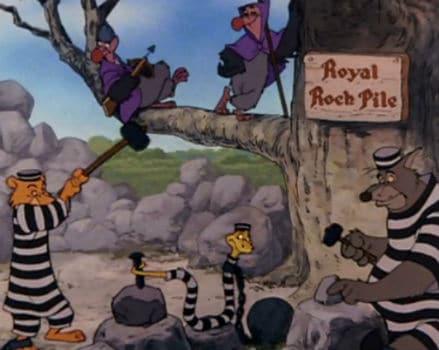
Fourthly, it’s important to have a balance between being practical and being bold. Part of what makes Little John and Robin Hood such a good team is that they are a good balance for each other. Robin Hood had the drive and the planning ability, but Little John was there to back him up and to, on occasion, probably reign in his more outrageous schemes. Friar Tuck is a good mix of the two of them, bold when he needs to be and not afraid to die for what he believes is right, but also very intentional and practical in his actions.
Finally, old classics can always be remade with new and exciting twists. Whether telling Robin Hood with animals, using a villain as the main character or placing the story in a new place and time, there are some stories that people have yet to get tired of. And there are always new ways to tell stories we love.
DOES IT HOLD UP?
As a youngling, this was my absolute favorite Disney movie. As an adult, I still really enjoy it. The backgrounds are pretty, the music is catchy, and the characters are delightful. Not only that, the story is a great blend of funny and poignant, and romance and adventure, a blend that can be hard to hit at times. If you haven’t seen it, or it’s been years, it’s instant on Netflix. Don’t miss the beautiful brawl; this is one Disney film that’s well worth the watch.
For next week: The Many Adventures of Winnie the Pooh
If you enjoyed this post and the others in the Revisiting Disney series, and have found yourself wishing that you could find them all in one convenient and bound book with eight extra essays, there is an option for you! Check out A Journey Through Disney: My Look Back Through Disney Canon, now available on Amazon as both a Kindle book ($4.99) and a paperback ($11.99).
OTHER SOURCES:
http://www.history.com/topics/1970s
http://studioservices.go.com/disneystudios/history.html
https://thewaltdisneycompany.com/about-disney/disney-history
Bailey, Adrian. Walt Disney’s World of Fantasy. Everest House Publishers. New York, New York. 1982.
Finch, Christopher. The Art of Walt Disney: From Mickey Mouse to the Magic Kingdom. Harry N. Abrams, Inc. New York, New York. 1975.
Sale, Roger. Fairy Tales and After: From Snow White to E.B. White. Harvard University Press. Cambridge, MA, 1978.
Tatar, Maria. The Annotated Classic Fairy Tales. W.W. Norton and Company. New York and London, 2002.
Thomas, Frank. Disney’s Art of Animation From Mickey Mouse to Hercules. Hyperion. New York, New York. 1992.
Wright, Gordon. The Ordeal of Total War: 1939-1945. Harper Torchbooks, Harper & Row. New York, Hagerstown, San Francisco, and London, 1968.
ARE YOU A ROMANCE FAN? FOLLOW THE SILVER PETTICOAT REVIEW:
 Our romance-themed entertainment site is on a mission to help you find the best period dramas, romance movies, TV shows, and books. Other topics include Jane Austen, Classic Hollywood, TV Couples, Fairy Tales, Romantic Living, Romanticism, and more. We’re damsels not in distress fighting for the all-new optimistic Romantic Revolution. Join us and subscribe. For more information, see our About, Old-Fashioned Romance 101, Modern Romanticism 101, and Romantic Living 101.
Our romance-themed entertainment site is on a mission to help you find the best period dramas, romance movies, TV shows, and books. Other topics include Jane Austen, Classic Hollywood, TV Couples, Fairy Tales, Romantic Living, Romanticism, and more. We’re damsels not in distress fighting for the all-new optimistic Romantic Revolution. Join us and subscribe. For more information, see our About, Old-Fashioned Romance 101, Modern Romanticism 101, and Romantic Living 101.

Comments are closed.